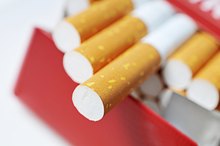What Are Some Solutions to Smoking?
People begin smoking for a variety of reasons, but after their health deteriorates, they often want to kick the habit. Since nicotine is a habit-forming drug, quitting can be a challenge for many smokers. Behavior modification, advance planning and diet alterations, as well as nicotine replacement and a strong emotional support system, may offer solutions to help smokers quit the habit.
Setting the Stage to Quit
Mentally preparing yourself for quitting gives you some time to adjust to the idea of being a non-smoker, according to the American Legacy Foundation, a smoking cessation organization. Instead of making a decision to quit immediately, give yourself time to get used to the idea. The Foundation suggests setting a date approximately five days in the future and using the days before your quit-date to inform your family and friends of your intentions and to rid your home of smoking-related items, such as ashtrays.
Launder your clothing to remove smoke smells and stock up on low-calorie finger foods to keep your hands and mouth busy when you quit. Make a list of all the positive aspects of kicking the habit and post it in plain sight.
- Mentally preparing yourself for quitting gives you some time to adjust to the idea of being a non-smoker, according to the American Legacy Foundation, a smoking cessation organization.
- The Foundation suggests setting a date approximately five days in the future and using the days before your quit-date to inform your family and friends of your intentions and to rid your home of smoking-related items, such as ashtrays.
Control Cravings
How do I Stop Smoking Cigars?
Learn More
Your body is accustomed to a nicotine fix several times during the day. When you quit, you may experience strong cravings to smoke, especially during the first few days.
Nicotine replacement products are available through your doctor or health clinic, and they include transdermal skin patches, nasal sprays and tablets. Some smokers find it beneficial to use these products to ease cravings while they focus on kicking the psychological side of their addiction. After a few weeks, you’ll gradually wean yourself from the nicotine replacement products. These products contain nicotine, but they do not contain the additional poisonous gasses found in cigarettes, according to Medline Plus, a branch of the National Institutes of Health.
Additional solutions include hypnosis, acupuncture and behavioral modification, according to HelpGuide.org. By altering habits associated with smoking, you may find it easier to quit. Eat at a different table, take a new route to work, spend time in non-smoking places such as libraries and avoid smoking triggers such as alcohol and coffee.
- Your body is accustomed to a nicotine fix several times during the day.
- Some smokers find it beneficial to use these products to ease cravings while they focus on kicking the psychological side of their addiction.
Prevent a Relapse
Having “just one cigarette,” can lead to another and another and soon, you’re back to smoking a pack a day. Although the urge to smoke lessens as time goes on, it’s imperative to resist the urge to light up even one cigarette.
The Mayo Clinic recommends reviewing your list of reasons for quitting while reminding yourself that you’ve already resisted previous urges.
Find an alternative solution for dealing with stress, which is one of the biggest relapse triggers for ex-smokers. Go for a brisk walk, practice deep breathing or learn to meditate. If you’re teetering on the brink of having a smoke, call a friend who you know will try to talk you out of it.
- Having “just one cigarette,” can lead to another and another and soon, you’re back to smoking a pack a day.
- If you’re teetering on the brink of having a smoke, call a friend who you know will try to talk you out of it.
Related Articles
References
- American Legacy Foundation: Quit Plan
- Help Guide: How to Quit Smoking
- Medline Plus: Nicotine Replacement Therapy
- Mendel JR, Baig SA, Hall MG, et al. Brand switching and toxic chemicals in cigarette smoke: A national study. PLoS One. 2018;13(1):e0189928. doi:10.1371/journal.pone.0189928
- Dorey A, Scheerlinck P, Nguyen H, Albertson T. Acute and chronic carbon monoxide toxicity from tobacco smoking. Mil Med. 2019;usz280. doi:10.1093/milmed/usz280
- Lestari KS, Humairo MV, Agustina U. Formaldehyde vapor concentration in electronic cigarettes and health complaints of electronic cigarettes smokers in Indonesia. J Environ Public Health. 2018;2018:9013430. doi:10.1155/2018/9013430
- Potvin S, Tikàsz A, Dinh-Williams LL, Bourque J, Mendrek A. Cigarette cravings, impulsivity, and the brain. Front Psychiatry. 2015;6:125. doi:10.3389/fpsyt.2015.00125
- McLaughlin I, Dani JA, De Biasi M. Nicotine withdrawal. Curr Top Behav Neurosci. 2015;24:99-123. doi:10.1007/978-3-319-13482-6_4
- Benowitz NL, Hukkanen J, Jacob P 3rd. Nicotine chemistry, metabolism, kinetics and biomarkers. Handb Exp Pharmacol. 2009;(192):29–60. doi:10.1007/978-3-540-69248-5_2
- Volkow ND, Wise RA, Baler R. The dopamine motive system: Implications for drug and food addiction. Nat Rev Neurosci. 2017;18(12):741–752. doi:10.1038/nrn.2017.130
- Bello HA, Dandare A, Danmaliki GI. Effects of cigarette smoking on lipid peroxidation and serum antioxidant vitamins. Int J Pharm Biol Sci. 2017;12(2):40-44. doi:10.9790/3008-1202044044
- Lin TW, Kuo YM. Exercise benefits brain function: The monoamine connection. Brain Sci. 2013;3(1):39–53. doi:10.3390/brainsci3010039
- Liu X, Li R, Lanza ST, Vasilenko SA, Piper M. Understanding the role of cessation fatigue in the smoking cessation process. Drug Alcohol Depend. 2013;133(2):548–555. doi:10.1016/j.drugalcdep.2013.07.025
- Stead LF, Carroll AJ, Lancaster T. Group behaviour therapy programmes for smoking cessation. Cochrane Database Syst Rev. 2017;3(3):CD001007. doi:10.1002/14651858.CD001007.pub3
Resources
Writer Bio
Glenda Taylor is a contractor and a full-time writer specializing in construction writing. She also enjoys writing business and finance, food and drink and pet-related articles. Her education includes marketing and a bachelor's degree in journalism from the University of Kansas.









